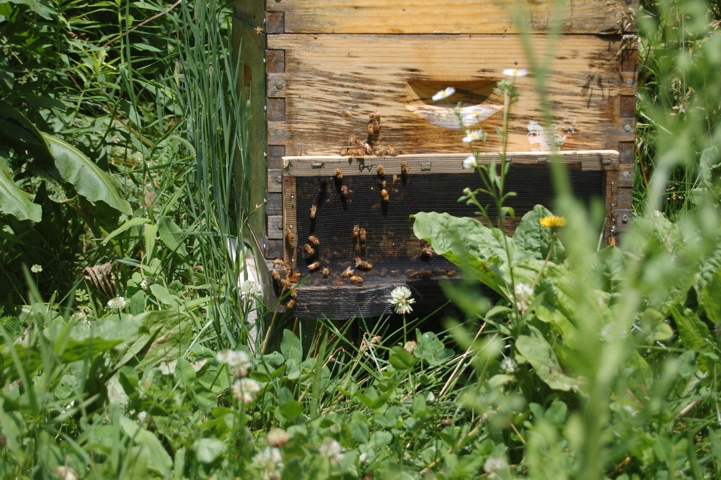A Home for Flora and Fauna: The Best Bees Company

The Waltham Field Station is famous for its flora. Farmland surrounds the administrative building, featuring an operating farm on one side, community garden plots on the other, and a CSA stand in between. The station’s old lab spaces are the birthplace of the most popular varieties of sweet corn and broccoli. Beloved and widely available today, butternut squash was accidentally invented by field station scientists in the 1940s.
More recently, however, the station has also become a home for plenty of fauna. The Charles River Dog Training Club, for example, brings local pups and their humans together for training and education. Waltham Fields Community Farm’s learning garden includes a henhouse with five chickens. The most recent addition to the field station’s menagerie came just this spring: towards the back tree line, the station hosts a row of honeybee hives.
The hives are maintained by The Best Bees Company, a local beekeeping service with a national vision. The company, started in 2010, is headquartered in Boston, but also collects data from beekeepers in New York City, Washington DC, and even Los Angeles. Best Bees is for-profit, but the data collection from all of the hives is organized by their affiliated non-profit organization, The Urban Beekeeping Laboratory and Bee Sanctuary.
These two organizations’ unique relationship began in 2014, when founder and Scientific Officer Noah Wilson-Rich split his work into two parts: one a daily beekeeping services company, and the other a research non-profit with the mission of “improving bee health.” Since the split, Best Bees has acquired locations nationwide, while the Urban Beekeeping Laboratory has partnered with researchers at MIT, Harvard, and even NASA to study bee behavior and the ecology of pollination. The two organizations also have their own app which Best Bees beekeepers can use to upload daily information from the hives they care for, so that Urban Beekeeping Laboratory researchers can track bee health with precision. I was thrilled to learn about the origins of the small row of beehives at the station, and had the privilege to speak with Sophie, Best Bees’ Head Beekeeper, to learn more.
On a typical day, Best Bees beekeepers head out with vans full of equipment to check each site with hives. Sophie explained that daily maintenance includes any necessary “regulation of the space,” which may mean adding or changing honeycombs, addressing growth, or harvesting honey if necessary. On top of that, beekeepers collect data to be sent back to the Urban Beekeeping Laboratory. They check for diseases, count populations of larvae and young bees, and check on the queen.
The hives at the station are new, established in April 2019. They function as reserve apiaries, housing extra stock which may be used if a Best Bees client starts a new hive or needs to repopulate an existing one. The farmland at the Waltham Field Station is an ideal home for these honeybees. Not only does it offer them open space, sun, and plenty of options for foraging, but it also is surrounded by suburbs. Surprisingly, honeybees do well in suburban environments because human activity creates more biodiversity than the monoculture of rural environments. Just like us, honeybees need a varied diet! With this in mind, Best Bees often chooses local farms close to towns and neighborhoods as the location for maintaining a reserve apiary.
Sophie says her favorite part of beekeeping is discovering “new surprises” every day. Beekeepers are constantly learning about bee behavior, hive maintenance, and the larger effect of pollinators in the environment. “You’ll look back,” she laughed, “and realize that a year ago you only knew half of what you know now.” Openness to growth and innovation is a major job requirement when beekeeping. Additionally, Sophie loves the community of Best Bees–working alongside other young beekeepers interested in addressing environmental issues, she has formed many friendships.
The honeybees at Waltham Field Station are newcomers, but they have plenty of examples to follow: some of Best Bees’ reserve apiaries have been around for more than a decade. If the Waltham Field Station’s rich history with flora is any indicator, the fauna will also fit in perfectly. We can’t wait to watch these hives grow!
If you are interested in employment with Best Bees, email info@bestbees.com or call 617-445-2322. They hire novice beekeepers! If you are interested in volunteering for the Urban Beekeeping Laboratory and Bee Sanctuary, email info@urbanbeelab.org. They always need more hands! Finally, contact your local and state legislators to support Waltham Field Station, so that it can be a home to honeybees for years to come!
By Anneke Craig, Boston Area Gleaners Intern